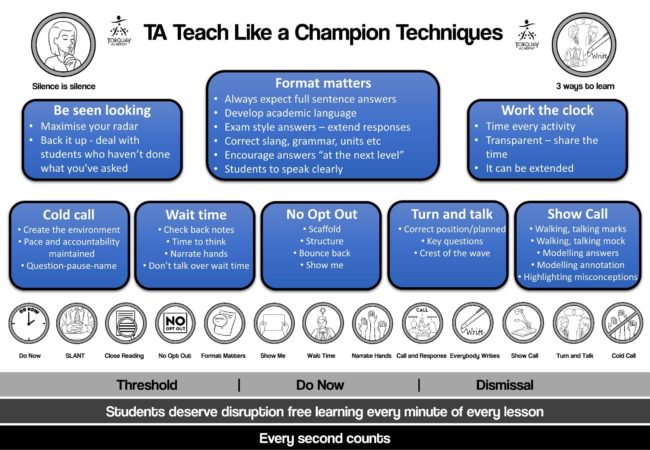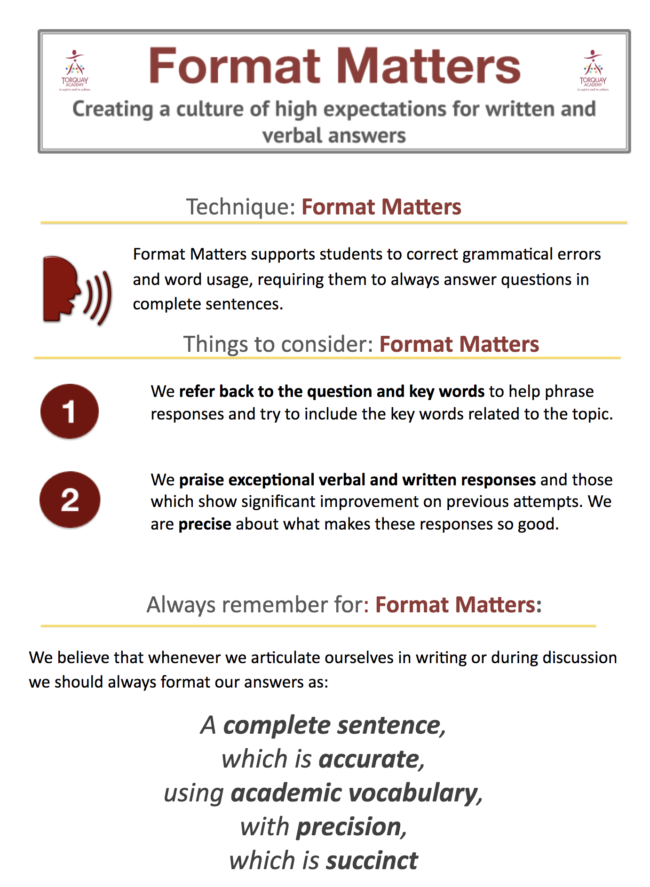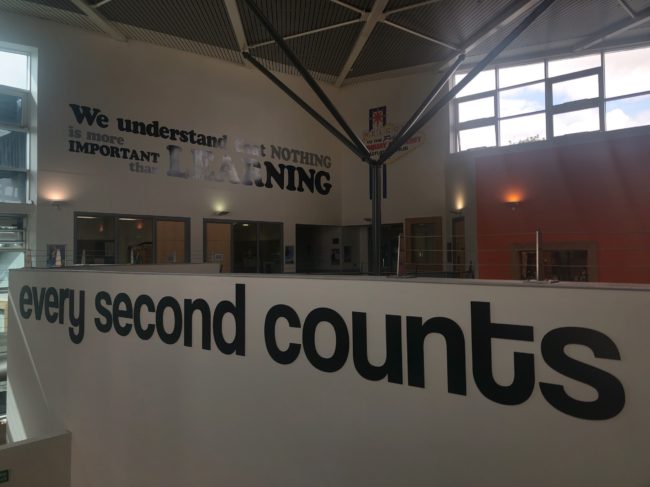11.28.18Learn Like A Champion–Torquay Academy’s Students Are In-The-Loop On TLAC

Margetts and some of his pupils
One of the highlights of my trip to the UK last June was visiting Torquay Academy in Devon- not just because it’s a really outstanding school where happy kids are given the gift of orderly school and rich, challenging instruction but–epiphany alert–because when teachers used techniques like Wait Time and Cold Call they were transparent with students–cooperative even. You see they had they explained the techniques teachers used to students in advance and why they were using them. Then at key points in the lesson teachers signaled to students that they were using them. And since students understood why–“Oh, this is a deep thinking question so my teacher is using Wait Time–they were partners in the execution of the techniques. It was a beautiful thing to behold and I asked Headteacher Steve Margetts if i could interview him about it.
First, Steve, tell readers a bit about Torquay Academy and what you and your staff have tried to do to change the school.
Torquay Academy is a mixed 11 to 18 school with just over 1,400 students based in a coastal town of 65,000 people. Our catchment area varies greatly in its demographics and includes areas that are among the most deprived in England as well as those which are more affluent. 40% of our pupils are classified as disadvantaged and 92% are White British. The benchmark of five GCSE passes including maths and English stood at 28% in 2014; this figure had increased to 74% by 2017. Back in 2014 the school wasn’t very popular with parents or students; it is now heavily oversubscribed with over 600 applications for our 240 places in Year 7 .
We have an incredible staff who believe that exceptional teaching can transform the life chances of young people.
How and why did you start using TLAC?
Before we introduced TLAC there were some excellent teachers who delivered lessons of the highest quality, but students were not receiving a consistent diet.
I had long been a fan of your Teach Like a Champion (TLAC) book as I believed it gave a simplicity and common language to our profession. I agree with your description of your book as being “about the tools of the teaching craft” and the fact it can support students who are facing “a rapidly closing window of opportunity”. I felt that the techniques would enable us to establish greater consistency within the school.
How did you introduce TLAC to your staff?
In September 2014, during my keynote at our first Teaching and Learning conference, I spoke about the importance of 100%, but delved no deeper into how to implement the technique. Unsurprisingly I saw no impact!
Then I attended the Engaging Academics Train a Trainer workshop that you held in London during October 2014. This was a watershed moment for me. I realised that TLAC techniques wouldn’t make their way into our classrooms simply by having copies of Teach Like a Champion and its associated workbook scattered around the school. To get TLAC strategies into our classrooms I would have to dedicate training time and give teachers the opportunity to practise those techniques prior to “going live” with them.Whilst practising a variety of techniques with colleagues from all over the UK my mind was racing about how to implement TLAC back at Torquay Academy.
Over the years we have learned that less is more in our professional development sessions. In the first session I delivered (we have a 2.5 hour twilight training session after school six times through the year) my plan was to go through Wait Time, Cold Call, Everybody Writes and No Opt Out. It was very apparent that I had overestimated what I would be able to get through in 2.5 hours. We managed Wait Time and Cold Call, I skipped Everybody Writes and rushed No Opt Out. I should have planned only for Wait Time and Cold Call.
We focus very much upon deliberate practise during our professional development sessions. During the first session giving our teachers the opportunity to practise the techniques together led to some initial embarrassment, but it passed quickly. Soon I was watching 70 colleagues practising with great enthusiasm and smiling as they did it.
The impact of our TLAC sessions was significant and immediate. Again, thinking back to that first session, I felt frustrated following it due to trying to squeeze too much into not enough time and I was concerned that I had wasted my first real TLAC opportunity. Those fears evaporated the following day as I walked around the school. In classroom after classroom I could hear teachers managing Wait Time, narrating hands and Cold Calling whilst students considered their responses. I had never seen such an impact from professional development! This was the correct approach.
What gave you the idea of intentionally sharing the strategies with students? Were you confident it would work? How did you start?
We had spent a lot of time working with our staff on how they could become better teachers, but comparatively, we had spent little time with our students on how they could become better learners. In your introduction to TLAC, you write “it’s about the tools necessary for success in the most important part of the field: teaching”. We speak to our students about aspirations and our expectations in terms of work ethic and behaviour, but I felt we could do more to equip them with the tools they needed for success in the most important part of the field: learning.
With Learn Like a Champion (LLAC) I wanted to cement our common language and have every member of staff establishing similar routines in their classrooms; LLAC was an opportunity to reinforce our key messages with staff and students. Using the language of “we…” signifies that both students and staff are behind great learning. Together we achieve.
How did the teachers react to the idea?
Very positively because they could see the impact of this in their classrooms. Rather than having individual teachers having to deliver rollouts in their own classrooms for the variety of techniques they would be utilising we were able to do this centrally to ensure students were familiar with what they would be expected to do.
They understand that we are trying to break out of the silo where only teachers are responsible for the delivery of TLAC.
How do you share TLAC strategies with your students now?
At the beginning of each year, we dedicate a day to what we call the TA Way (students new to the school have three days). During this time we recap our expectations in a wide range of areas from behaviour, transitions and completion of homework. One of these sessions is dedicated to Learn Like a Champion.
This session gives students a reminder of the key TLAC strategies that we use in school; a summary of these is displayed on a place mat on every teachers’ lectern in their classroom

To re-enforce the students’ understanding throughout the year we have a TLAC technique of the fortnight. During our Monday morning staff briefing our Assistant Principal responsible for staff development, Harrison Littler, quickly reviews the impact of the previous two weeks and suggests a couple of ways that we could improve its use moving forwards. He then runs through a PowerPoint outlining this fortnight’s technique. As part of this staff are also shown a video of the technique being used effectively by one of our teachers. They are all given a reminder sheet for them to have to hand during lessons. For example, our current technique of the fortnight is Format Matters.

Harrison also delivers this presentation to every year group in the school during their morning assembly. He clarifies why the technique is important for their learning and what they will be expected to do.
Harrison has the strategic oversight of which technique we choose for each fortnight. He takes feedback from our team of coaches along with what we are seeing in the classrooms every day to inform his decision.
Can you give us an example or two of how LLAC (Learn Like a Champion) might play out in the class room. I’m pretty sure that when I visited Torquay I saw a teacher ask a question and drop in the phrase ‘wait time’ afterwards. And there were times when there were icons displayed on ppt, for example- tell us how and why teachers did this?
When we unpacked each technique using the templates you provided on your Practice Perfect workshop, we realised for each one to be effective there was clearly a set role for teachers to play, but there was also a specific role for students to play for any technique to be used successfully. This is why we train the students about their role and then highlight this to them in lessons. For example, teachers will use one or more of the range of icons that we commissioned on their presentations to indicate to students what their expectations will be for that part of the lesson and they will often verbally reinforce them.

Icons indicate to students what techniques to expect
Teachers might highlight that they will be Cold Calling or providing Wait Time to consider their responses. This week I have seen teachers responding to answers by simply saying “format matters” and students have understood that they need to improve their answer and then used some of the techniques we have shared with them.
What do the students make of it?
The students recognise that there is deliberate planning behind what is happening in the different classrooms and they enjoy the consistent and coherent experience. Like any routine, there are different stages of automaticity, but the revisiting of the techniques through the year ensure both staff and students improve in their use of the range of TLAC techniques.
They understand it as being part of Torquay Academy where we frequently talk about “there is nothing more important than learning” and “every second counts”.

What have the results been?
Quite simply, more gets done in every lesson. Given that teachers use TLAC techniques in a consistent fashion and the students have clarity on what is expected of them it reduces the transaction costs as the need for a back to basics rollout is avoided.
Since we have started LLAC I have seen a big difference in how students respond to questions in the classroom. The clearest area of improvement as I walk around the school is the engagement of the students. Students are much more likely to be active participants in lessons, using academic language, and less likely to opt out of answering or give one-word responses.
When/how did you know it was working?
During an open day last year I was showing a group of parents around the school with one of our Vice Principals, Mark Bindon, and he asked a Year 7 student who had only been in the school for four weeks what lessons she enjoyed the most. Her response was, “I like all of my lessons as they all follow a similar structure. Our teacher meets at the threshold and we walk silently into the classroom where we start our Do Now. The teacher will then either Cold Call on us for a response or we can put our hands up to give an answer. I like it when we can do Turn and Talks with our partners as well”. That was the moment!
Any lessons learned for other schools that may want to try this?
I would ensure the students know why you are doing it and embed that reason in your whole school vision and values. I think it is important that LLAC isn’t seen by the students as another set of rules and expectations, it is seen as engaging them into being more effective students that will help them to learn more.
I would also start with the key TLAC techniques that you want them to be able to master and try not to introduce too many, too quickly.
